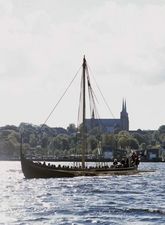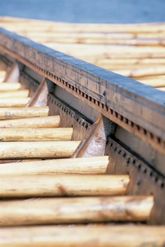The Viking longship sails again
By Tinna Damgård-Sørensen, director of the Viking Ship Museum
A Viking ship, a dream – and an enormous challenge. The Sea Stallion from Glendalough will sail across the North Sea to Dublin in 2007, returning to Roskilde in 2008. The voyage will mark the climax of the project known as Thoroughbred of the Sea, the most ambitious ship archaeology research project ever undertaken. His Royal Highness Crown Prince Frederik is patron of the expedition.
The Sea Stallion from Glendalough is a reconstruction of the 30-meter-long warship exhibited in the Viking Ship Museum. Representing the pinnacle of Viking technology, she is one of the ocean-going longships whose praise is sung in sagas and skaldic verse. The original vessel was built by Vikings in Dublin and ended her days in the late 11th century when she was scuttled to block Roskilde Fjord.
The Sea Stallion from Glendalough was built at the museum's boatyard in 2000-2004. She was built with replicas of Viking tools, using the same methods and materials as in the original ship. And the result is spectacular. Form, function and aesthetics are taken to a higher level in synergy with the materials and traditional craftsmanship. A design that was admired and revered a thousand years ago and continues to attract attention to this very day. The ship is among the twelve representatives of outstanding Danish design and craftsmanship singled out in the Cultural Canon recently compiled by the Danish Minister for Culture.
The Sea Stallion from Glendalough is now to be sent on an expedition to the very same waters her ancestor crossed – the North and Irish Seas. The purpose of the voyage is to test and document the seaworthiness, speed and manoeuvrability of the ship on the rough open sea and in coastal waters with treacherous currents. The crucial question is how the long, narrow, flexible hull will withstand the onslaught of ocean waves. The expedition will not only allow us to test the ship herself, but will also provide valuable new information on Viking longships and society.
The ship will be manned by members of the Viking Ship Museum staff and 120 volunteers who will take turns in joining the 70-man crew. The project will also cast new light on the organisation necessary for the crew to function satisfactorily, both aboard the vessel and on land. In addition, the expedition will be an interesting social experiment – how will 70 present-day individuals react to being confined to an open-decked ship, with little room for private life or home comforts, on the open seas, where anything can happen. The voyage will thus provide new insights into the hearts, minds and spirits of the Vikings – while teaching us a thing or two about ourselves.
The overall objective of the project is cultural historical, and expedition findings will be published scientifically and communicated to the general public via exhibitions, filmed documentaries, books, etc. Expeditions have always been exciting news, and the Sea Stallion's adventures will be told on the museum website and in its exhibitions as well as in the media and films. The project will be accompanied by Danish-Irish cooperation on culture, education and commerce, and will for example be the subject of TV programmes.
We eagerly await the experience and knowledge the expedition and the ship herself will bring, and hope that many people will be interested in following the adventures of the Sea Stallion and her crew on this truly epic voyage.
Kind regards
Tinna Damgård-Sørensen
Director of the Viking Ship Museum in Roskilde

